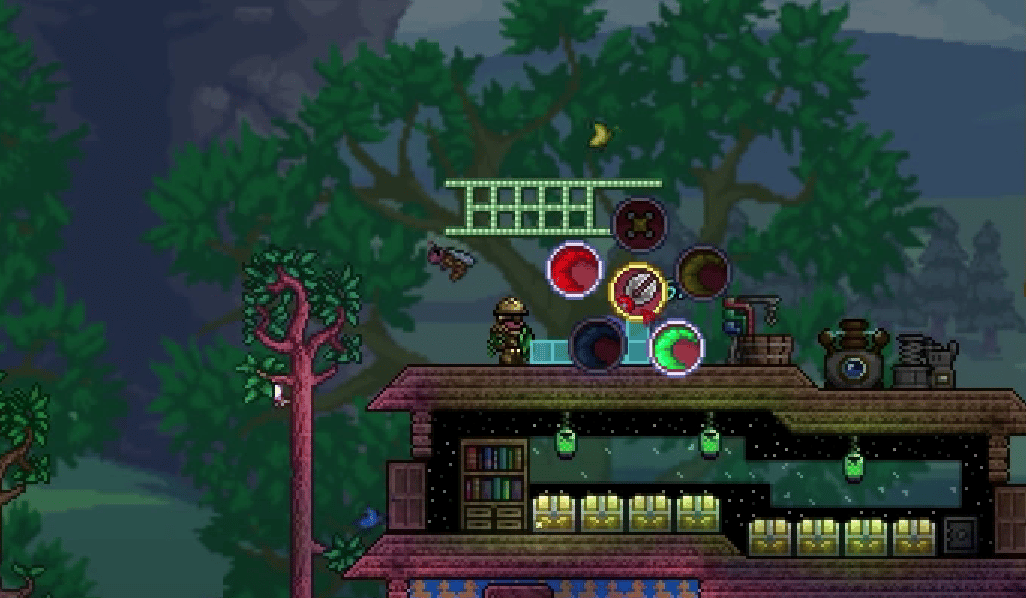Terraria corruptible blocks slowly convert the world of Terraria. The infection spreads around, destroying the surrounding tiles, thus turning them into Corruption, Crimson, and Hallow biome. Not only does this impact aesthetics, but it also destroys other biomes that are necessary to complete the game.
To fix the issue, you need to isolate the whole infectious area. Alternatively, you can just isolate your base and the Jungle biome, which is important for game progress. Read this guide to learn how to do that!
How do blocks get infected?
Hallow, Crimson, and Corruption biomes are completely different from other areas as they’re able to convert their surroundings. As you can presume, they can only infect nearby tiles, turning them to their respective ground. When the tiles change, so do the flora and fauna of the respective area.
Each of these biomes has a slightly different mechanism of spread. All those tiles that are susceptible to Corruption, Crimson, and Hallow are jointly called Terraria corruptible blocks. On the other hand, those that can’t be corrupted are referred to as non-corruptible. We also have tiles that could be infected but aren’t. These are called pure blocks.
When does conversion start?
The conversion starts the same moment the game starts. It becomes especially troublesome once you kill Wall of Flesh and transition into Hardmode. Ideally, you should take preventative measures before killing this boss so that the corruption doesn’t spread to your base. Once you kill Plantera, it reverts to the pre-Hardmode level.
The spread is so fast that it can easily take off-guard inexperienced players. Luckily, there are few rules and limitations regarding the spread. If you react in the right manner, you can slow down further corruption of the world. However, if you’re complacent, rest assured that infectious biomes will eventually take over the map.
Tile update cycle
The conversion occurs as a part of Terraria’s tile update cycle. They happen after every single tick (approximately 1/60th of a second). During tile update, the algorithm chooses a certain number of blocks to update. This affects several in-game processes, most importantly, biome spread.
It’s also important to note that the tile update cycle affects surface blocks and underground blocks differently. Surface blocks experience a change every 140 seconds or so, while these changes occur several times slower for underground blocks (approximately every 830 seconds).
In other words, when looking for the first signs of corruption, you should focus on above-ground tiles. This surface updates much quicker, and when infection starts spreading towards your base, it’ll most likely spread from the surface area.
Keep in mind that the selection of tiles is random. You won’t know how quickly infection will spread around, as the block updates can vary significantly. As soon as a new tile becomes Crimson, Hallow, or Corrupt, it’s considered a new source tile that will serve to spread the infection further.
How do Terraria corruptible blocks affect the game?
The biggest issue with corruptible blocks is that they start affecting larger and larger surfaces as the game goes on. This is especially noticeable at the start of the Hardmode. Perhaps the only benefit to world infection is that you can access new ingredients such as Deathweed. However, that doesn’t mean you should allow it to spread.
Here are the main problems with Corrupt and Crimson (also referred to as evil biomes) spread:
- It eliminates all the sea life from the ocean.
- You can no longer acquire Waterleaf from the Desert biome.
- When the Jungle becomes corrupt, the standard enemies will be replaced by Corrupt or Crimson opponents.
- Thorns are constantly growing from the ground, damaging characters as they travel.
- There’s much less light, and the game becomes a real nuisance.
- Your NPCs will not spawn in infected areas.
So, with the destruction of other biomes, you can’t access certain ingredients and loot. This also means you won’t be able to fight certain bosses. Sections of the Corrupt and Crimson biome will spawn new, tougher enemies.
Hallow is the third type of corruption, which is slightly better than Corrupt and Crimson:
- It doesn’t disrupt the normal functioning of the Desert, Jungle, or Ocean.
- You get access to Pixies, which are important for top-tier Healing Potions.
- The Crystals provide a lot of light while underground.
- Most of the Hallow enemies are less annoying than Crimson and Corrupt enemies.
How to stop the spread of infection?
The concept of infection isn’t that important at the beginning of the game. Even if you play pre-Hardmode dozens of times, there’s a good chance you won’t notice the issue.
The first time we spotted the problem was when we first reached Hardmode. If you’re too complacent and don’t focus on objectives, there’s a good chance that the infectious biome will spread to your base. This is a major issue as it’ll prevent NPCs from spawning. In other words, you might no longer have access to basic features such as the shop.
Here are some tips that’ll help you tackle infection:
- The best way to prevent spread to your base is to elevate the structure. You can do this at the very start of the game by creating Wooden or Stone Platforms and building a house above ground level. Later on, you can use the same platforms or a Rope to reach the base.
- Alternatively, you can dig a large moat around it, in all directions, including underground. The moat should be 3 to 6 blocks wide.
- You can also spread corruption with Wood blocks, as this material is not affected by the infection.
- Alternatively, you can create a massive underground tunnel on both sides of the Crimson/Hallow/Corrupt biome. It should go all the way to lava level. That way, even if the whole section is converted alongside vertical lines, it won’t spread horizontally.
- Sunflowers are one of the rare plants that can slow down the infection. They can have a major impact on the conversion of surface blocks, although they are less effective on Hardmode.
- Purification Powder is one of the ways to stop corruption without digging tunnels. However, this material can be very expensive, even if you have a massive bank. Instead of using it, it’s better to wait for Clentaminator to become available.
- Speaking of Clentaminator, this is the only tool in the game that can reliably remove infectious biomes. The only issue is that it’s available rather late in the game, so by the time you get it, your base might already be infected.
Other things to consider
There are other important things to keep in mind when it comes to the spread of evil biomes and Hallow:
- The conception of corruption is so important that you need to plan for it ahead of time. In fact, you should make the first steps against Crimson, Hallow, and Corrupt biomes as soon as you start the game. No matter what, don’t kill Wall of Flesh unless you’re certain that you’ve properly tackled the corruption spread.
- When people reach Hardmode for the first time, they often struggle against bosses with their old gear. So, they’ll start digging Hardmode ores and building newer items. This often takes too much time, and the infectious biomes will spread while they’re occupied.
- Tackling infectious biomes is less important on larger maps. The spread is not that noticeable, giving you more leeway for messing around. Unfortunately, this also means you’ll need more time to remove corrupted blocks once you finally get to it.
- Although the rate of conversion stays the same no matter what, it has a different impact depending on the biome. Most notably, it spreads faster based on the concentration of convertible blocks. If there aren’t many convertible blocks around, it’ll be much harder for Hallow, Corrupt, and Crimson to spread.
- Considering the previous entry, it makes sense that corruption spread quickest in the Desert and Beach biomes due to the high concentration of blocks. Underground Snow, Jungle, and Forest are much more resilient, while Surface Snow is the hardest to convert. The infection cannot spread to Mushroom Grass.
- Whenever you smash Crimson or Corrupt Altair, a random block in the world is converted to Crimson or Corrupt Block. This can be a major issue if the tile spawns in a non-quarantined area. Avoiding the destruction of Altars is a good way to prevent the quick corruption of the world.
- Aside from your base, the Jungle biome is crucial for finishing the game. If you allow its conversion, you won’t be able to reach the end game bosses. Create an additional layer of protection around this biome. Aside from building a moat, you can place Hallowed Blocks around its perimeter as they won’t covert Jungle Biome.
- Although it feels like the best solution is to completely destroy the whole Crimson/Corrupt biome, this will prevent you from getting certain items.
- Lava Blocks can be useful for protecting surface biomes, which is the biggest issue you need to consider.




